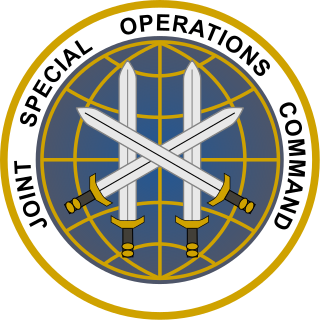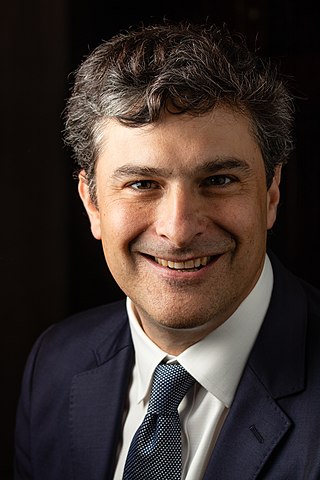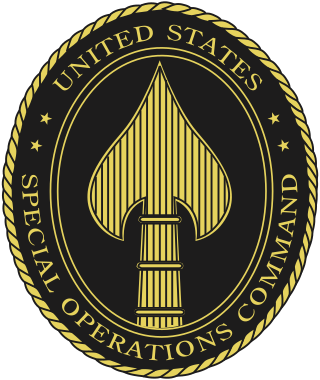Related Research Articles

The Defense Intelligence Agency (DIA) is an intelligence agency and combat support agency of the United States Department of Defense, specializing in defense and military intelligence.

The United States Central Command is one of the eleven unified combatant commands of the U.S. Department of Defense. It was established in 1983, taking over the previous responsibilities of the Rapid Deployment Joint Task Force (RDJTF).

The Special Activities Center (SAC) is a division of the United States Central Intelligence Agency responsible for covert and paramilitary operations. The unit was named Special Activities Division (SAD) prior to 2015. Within SAC there are two separate groups: SAC/SOG for tactical paramilitary operations and SAC/PAG for covert political action.

The Inter-Services Intelligence is the largest and best-known component of the Pakistani intelligence community. It is responsible for gathering, processing, and analyzing any information from around the world that is deemed relevant to Pakistan's national security. The ISI reports to its director-general and is primarily focused on providing intelligence to the Pakistani government.

The Joint Special Operations Command (JSOC) is a joint component command of the United States Special Operations Command (USSOCOM) and is charged with studying special operations requirements and techniques to ensure interoperability and equipment standardization, to plan and conduct special operations exercises and training, to develop joint special operations tactics, and to execute special operations missions worldwide. It was established in 1980 on recommendation of Colonel Charlie Beckwith, in the aftermath of the failure of Operation Eagle Claw. It is headquartered at Pope Field.

The Central Intelligence Agency, known informally as the Agency and historically as the Company, is a civilian foreign intelligence service of the federal government of the United States, officially tasked with gathering, processing, and analyzing national security information from around the world, primarily through the use of human intelligence (HUMINT) and conducting covert action through its Directorate of Operations. As a principal member of the United States Intelligence Community (IC), the CIA reports to the Director of National Intelligence and is primarily focused on providing intelligence for the President and Cabinet of the United States. Following the dissolution of the Office of Strategic Services (OSS) at the end of World War II, President Harry S. Truman created the Central Intelligence Group under the direction of a Director of Central Intelligence by presidential directive on January 22, 1946, and this group was transformed into the Central Intelligence Agency by implementation of the National Security Act of 1947.

The Battle of Tora Bora was a military engagement that took place in the cave complex of Tora Bora, eastern Afghanistan, from November 30 – December 17, 2001, during the final stages of the United States invasion of Afghanistan. It was launched by the United States and its allies with the objective to capture or kill Osama bin Laden, the founder and leader of the militant organization al-Qaeda. Al-Qaeda and bin Laden were suspected of being responsible for the September 11 attacks three months prior. Tora Bora is located in the Spīn Ghar mountain range near the Khyber Pass. The U.S. stated that al-Qaeda had its headquarters there and that it was bin Laden's location at the time.
Hassan Ghul, born Mustafa Hajji Muhammad Khan, was a Saudi-born Pakistani member of al-Qaeda who revealed the kunya of Osama bin Laden's messenger, which eventually led to Operation Neptune Spear and the death of Osama Bin Laden. Ghul was an ethnic Pashtun whose family was from Waziristan. He was designated by the Al-Qaida and Taliban Sanctions Committee of the Security Council in 2012.

The insurgency in Khyber Pakhtunkhwa, also known as the War in North-West Pakistan or Pakistan's war on terror, is an ongoing armed conflict involving Pakistan and Islamist militant groups such as the Tehrik-i-Taliban Pakistan (TTP), Jundallah, Lashkar-e-Islam (LeI), TNSM, al-Qaeda, and their Central Asian allies such as the ISIL–Khorasan (ISIL), Islamic Movement of Uzbekistan, East Turkistan Movement, Emirate of Caucasus, and elements of organized crime. Formerly a war, it is now a low-level insurgency as of 2017.

The war on terror, officially the Global War on Terrorism (GWOT), is a global military campaign initiated by the United States following the September 11 attacks and is the most recent global conflict spanning multiple wars. The main targets of the campaign are militant Islamist movements like Al-Qaeda, Taliban and their allies. Other major targets included the Ba'athist regime in Iraq, which was deposed in an invasion in 2003, and various militant factions that fought during the ensuing insurgency. After its territorial expansion in 2014, the Islamic State militia has also emerged as a key adversary of the United States.

Michael George Vickers is an American defense official who served as the Under Secretary of Defense for Intelligence (USD-I). As USD-I, Vickers, who was appointed by President Barack Obama in 2010, was the Defense Department's top civilian military intelligence official. Before becoming USD-I, Vickers served as Assistant Secretary of Defense for Special Operations and Low Intensity Conflict.

After the Central Intelligence Agency lost its role as the coordinator of the entire Intelligence Community (IC), special coordinating structures were created by each president to fit his administrative style and the perceived level of threat from terrorists during his term.
Various conspiracy theories allege that certain institutions or individuals had foreknowledge of the September 11 attacks in the United States in 2001. Some of the primary debates include whether the Bush administration or the United States Armed Forces had awareness of the planned attack methods, the precise volume of intelligence that American agencies had regarding al-Qaeda activities inside the United States, whether the put options placed on United Airlines and American Airlines and other trades indicated foreknowledge, and why the identities of the traders have never been made public.
This is a list of activities ostensibly carried out by the U.S. Central Intelligence Agency (CIA) within Pakistan. It has been alleged by such authors as Ahmed Rashid that the CIA and ISI have been waging a clandestine war. The Afghan Taliban—with whom the United States was officially in conflict—was headquartered in Pakistan's Federally Administered Tribal Areas during the war and according to some reports is largely funded by the ISI. The Pakistani government denies this.

The War in Afghanistan was an armed conflict from 2001 to 2021. It was the direct response to the September 11 attacks. It began when an international military coalition led by the United States launched an invasion of Afghanistan, declaring Operation Enduring Freedom as part of the earlier-declared war on terror; toppling the Taliban-ruled Islamic Emirate and establishing the Islamic Republic three years later. The Taliban and its allies were expelled from major population centers by the US-led forces, supporting the anti-Taliban Northern Alliance; however Bin Laden relocated to neighboring Pakistan. The conflict officially ended with the 2021 Taliban offensive, which overthrew the Islamic Republic, and re-established the Islamic Emirate. It was the longest war in the military history of the United States, surpassing the length of the Vietnam War (1955–1975) by approximately 6 months.

Mark Mazzetti is an American journalist who works for the New York Times. He is currently a Washington Investigative Correspondent for the Times.
The Afghan War documents leak, also called the Afghan War Diary, is the disclosure of a collection of internal U.S. military logs of the War in Afghanistan, which were published by WikiLeaks on 25 July 2010. The logs consist of over 91,000 Afghan War documents, covering the period between January 2004 and December 2009. Most of the documents are classified secret. As of 28 July 2010, only 75,000 of the documents have been released to the public, a move which WikiLeaks says is "part of a harm minimization process demanded by [the] source". Prior to releasing the initial 75,000 documents, WikiLeaks made the logs available to The Guardian, The New York Times and Der Spiegel in its German and English online edition, which published reports in line with an agreement made earlier the same day, 25 July 2010.

The United States Special Operations Command is the unified combatant command charged with overseeing the various special operations component commands of the Army, Marine Corps, Navy, and Air Force of the United States Armed Forces. The command is part of the Department of Defense and is the only unified combatant command created by an Act of Congress. USSOCOM is headquartered at MacDill Air Force Base in Tampa, Florida.

Timber Sycamore was a classified weapons supply and training program run by the United States Central Intelligence Agency (CIA) and supported by some Arab intelligence services, including Saudi intelligence. The aim of the programme was to remove Syrian president Bashar al-Assad from power. Launched in 2012 or 2013, it supplied money, weaponry and training to Syrian opposition militias of the Free Syrian Army fighting al-Assad's forces in the Syrian civil war. According to US officials, the program was run by the CIA's Special Activities Division and has trained thousands of rebels. President Barack Obama secretly authorized the CIA to begin arming Syria's embattled rebels in 2013. The program became public knowledge in mid-2016.

On 26–27 October 2019, the United States conducted a military operation code named Operation Kayla Mueller that resulted in the death of Abu Bakr al-Baghdadi, the then-leader and self-proclaimed caliph of the Islamic State (IS) terrorist organization. The operation took place in the outskirts of Barisha, Idlib Governorate, Syria. According to General Kenneth F. McKenzie Jr., the United States Central Command (CENTCOM) commander who oversaw the operation, Baghdadi killed himself along with two children when he detonated a suicide belt while seeking to evade U.S. forces during the raid.
References
- 1 2 3 Mazzetti, Mark; Dave Rodhe (June 30, 2008). "Amid Policy Disputes, Qaeda Grows in Pakistan". The New York Times . Retrieved June 30, 2008.
- 1 2 "Secret US military plan for Pakistan on hold-report". Reuters. June 30, 2008. Retrieved June 30, 2008.
- 1 2 McLeod, Judi (June 30, 2008). "New York Times again exposes 'highly classified Pentagon order'". Canada Free Press . Retrieved June 30, 2008.
